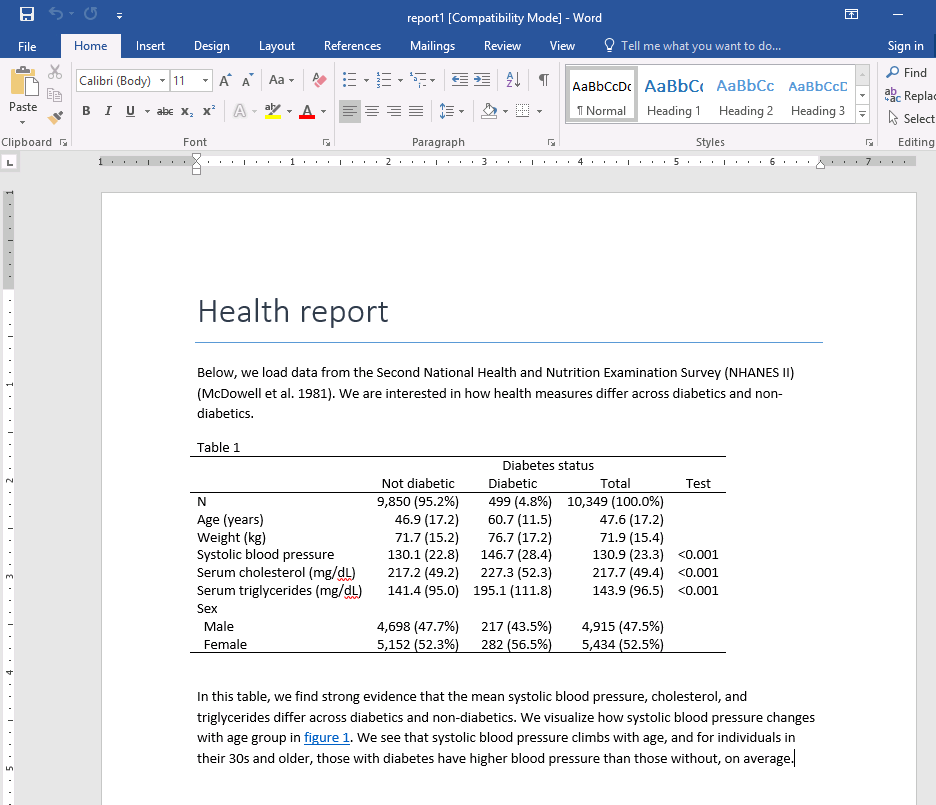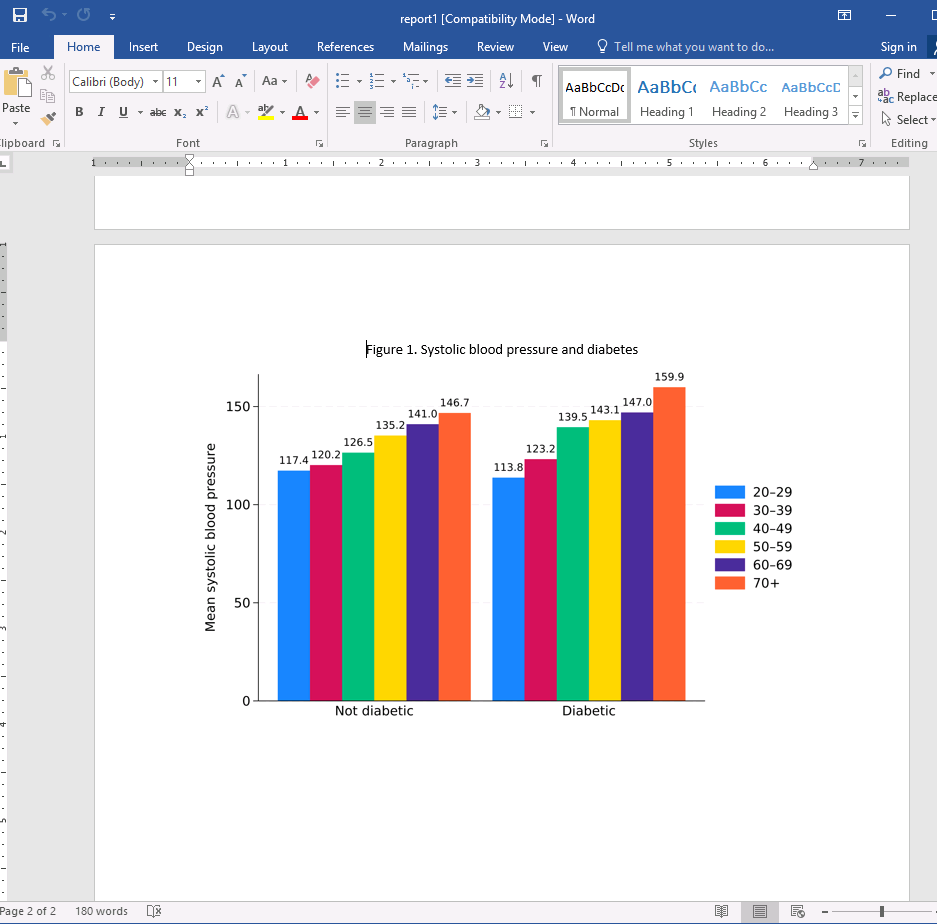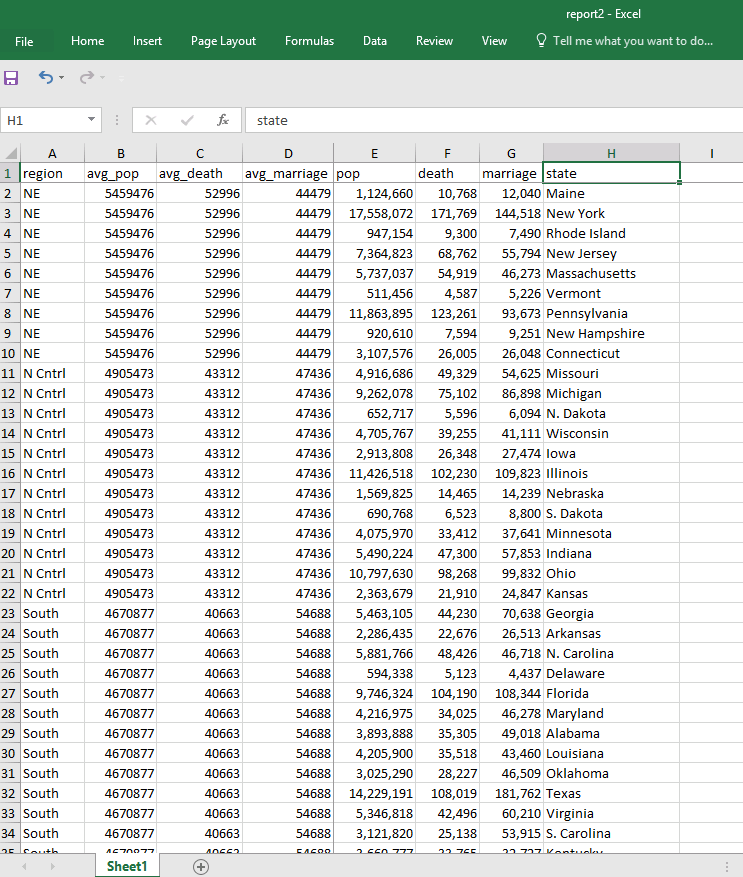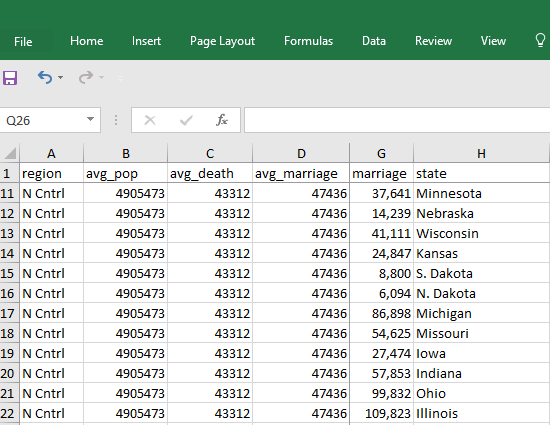← See Stata 19's new features
Highlights
New in putdocx
Include bookmarks in paragraphs and tables
Include alternative text to be read by voice software for images
Include Scalable Vector Graphics (.svg) images
New in putexcel
Freeze a worksheet at a specific row or column
Insert a page break at a specific row or column
Insert a header and footer into a worksheet
Include hyperlinks in cells
Create a named cell range
See more reporting features
Reproducible reports allow us to streamline the process of presenting our findings as our analyses change. Whether the direction of our work changes or we implement feedback from our peers, creating a report with the findings of our research is rarely a one-time task. Stata's reproducible reporting features allow us to easily modify and adapt our reports as our analyses change.
We added features for putdocx and putexcel that allow you to further customize your reproducible reports. Now you can include headers, footers, and page breaks with putexcel. You can also freeze a row or column in the worksheet; this allows you to maintain information from that row or column in view, while scrolling through the rest of the sheet. Additionally, you can create a named cell range to simplify working with formulas. We have also added support for bookmarks with putdocx; simply format your text as a bookmark, and link to it as needed. Additionally, when adding an image to a .docx file, you can now specify alternative text for the image to be read by voice software.
The dtable command is another new reporting feature. Learn more here about how you can use it to easily create a table of descriptive statistics, often called a "Table 1".
-> Creating a Word document with a bookmark
-> Creating an Excel file with locked cells
-> Materials
We have data from the Second National Health and Nutrition Examination Survey (NHANES II) (McDowell et al. 1981). We are interested in how health measures differ across diabetics and nondiabetics. We begin by creating a "Table 1":
. webuse nhanes2l, clear
(Second National Health and Nutrition Examination Survey)
. dtable age weight bpsystol tcresult tgresult i.sex, by(diabetes, tests)
title(Table 1) continuous(age weight, test(none)) factor(sex, test(none))
nformat(%6.1f mean sd) export(table1.docx)
note: using test regress across levels of diabetes for bpsystol, tcresult,
and tgresult.
Table 1
| Diabetes status Not diabetic Diabetic Total Test | |
| N 9,850 (95.2%) 499 (4.8%) 10,349 (100.0%) Age (years) 46.9 (17.2) 60.7 (11.5) 47.6 (17.2) Weight (kg) 71.7 (15.2) 76.7 (17.2) 71.9 (15.4) Systolic blood pressure 130.1 (22.8) 146.7 (28.4) 130.9 (23.3) <0.001 Serum cholesterol (mg/dL) 217.2 (49.2) 227.3 (52.3) 217.7 (49.4) <0.001 Serum triglycerides (mg/dL) 141.4 (95.0) 195.1 (111.8) 143.9 (96.5) <0.001 Sex Male 4,698 (47.7%) 217 (43.5%) 4,915 (47.5%) Female 5,152 (52.3%) 282 (56.5%) 5,434 (52.5%) | |
In this table, we see the average weight, systolic blood pressure, cholesterol, and triglycerides for each group. We have also performed a test of equality between diabetics and nondiabetics for the three health measures; we suppressed these tests for age, weight, and sex. With a single command, we are able to create and export this table to a Word-compatible file (table1.docx). However, we wish to include this table in a report along with a graph, text, and other content, which we do below.
We will begin by creating an active document, adding a title and an introduction to our analysis:
putdocx begin putdocx textblock begin, style(Title) Health report putdocx textblock end putdocx textblock begin Below, we load data from the Second National Health and Nutrition Examination Survey (NHANES II) (McDowell et al. 1981). We are interested in how health measures differ across diabetics and non-diabetics. putdocx textblock end
Then, we will include the table we created above, although this time we won't need the export() option. Instead, we use collect style putdocx to resize the column widths to fit the contents and use putdocx collect to insert the table in our document.
. quietly: dtable age weight bpsystol tcresult tgresult i.sex, by(diabetes, tests) title(Table 1) continuous(age weight, test(none)) factor(sex, test(none)) nformat(%6.1f mean sd) . collect style putdocx, layout(autofitcontents) . putdocx collect (collection DTable posted to putdocx)
Next, we discuss the results of our table and link to figure 1. Although we have yet to create the bookmark called bmark1, we format the text "figure 1" as a link to the bookmark.
putdocx textblock begin
In this table, we find strong evidence that the mean systolic blood pressure,
cholesterol, and triglycerides differ across diabetics and non-diabetics. We
visualize how systolic blood pressure changes with age group in
<<dd_docx_display bookmarklink("bmark1"): "figure 1">>. We see that systolic
blood pressure climbs with age, and for individuals in their 30s and older,
those with diabetes have higher blood pressure than those without, on
average.
putdocx textblock end
Finally, we create a bar graph to visualize the average systolic blood pressure for each age group and category of diabetes. We export our graph to an SVG file and add a title to the image. The title is "Figure 1. Systolic blood pressure and diabetes", which we format as a bookmark. Then we export our image by using putdocx image and specify alternative text to be read by voice software. Last, we save our work.
. graph bar (mean) bpsystol, over(agegrp) over(diabetes)
asyvars blabel(bar, format(%6.1f)) ytitle(Mean systolic blood pressure)
. graph export graph1.svg, replace
file graph1.svg saved as SVG format
. putdocx paragraph, halign(center)
. putdocx text ("Figure 1. Systolic blood pressure and diabetes"),
bookmark("bmark1")
. putdocx image graph1.svg, linebreak
alt("Graph of systolic blood pressure and diabetes")
. putdocx save report1, replace
successfully replaced "C:/Users/Stata/report1.docx"
This creates the following document:

We can see that "figure 1" is a link; once we click on it, we are taken to Figure 1:

We have data from the 1980 census that we wish to export to an Excel file. We are interested in how the population, number of deaths, and marriages vary across each region of the United States. First, we compute the mean for pop, death, and marriage. We then export our variables of interest to a file called report2.xlsx with export excel. The first row will contain the variable names, and the first four columns will record the region and averages we computed. To modify this file, we use putexcel set with the modify option. We split the worksheet at the first row and the fourth column with option split(1,4). In other words, we lock this row and column to keep the averages in view, while we scroll through the information for each state.
. webuse census, clear
(1980 Census data by state)
. foreach x of varlist pop death marriage {
2. bysort region: egen avg_`x' = mean(`x')
3. }
. export excel region avg_* pop de marriage state using report2.xlsx,
firstrow(variables) replace
file report2.xlsx saved
. putexcel set report2.xlsx, modify
. putexcel sheetset, split(1, 4)
file report2.xlsx saved
. putexcel save
Here is our resulting document:

We can now scroll down to other regions while maintaining the column names in view and scroll to the right while maintaining the averages in view:

As we scroll down to the North Central region, we see an average of 47,436 marriages per state; Illinois had the most, 109,823.
We might also store summary statistics for each region in one worksheet and hyperlink to the table from another sheet with the new support for hyperlinks. We could customize our worksheet further by including a header, footer, or page break. See [RPT] putexcel for more information.
You can download the do-file and resulting documents created in the above examples by typing
. copy https://www.stata.com/stata18/reporting-features-do
. copy https://www.stata.com/stata18/reporting-features-report1.docx
. copy https://www.stata.com/stata18/reporting-features-report2.xlsx
McDowell, A., A. Engel, J. T. Massey, and K. Maurer. 1981. Plan and operation of the Second National Health and Nutrition Examination Survey, 1976–1980. Vital and Health Statistics 1: 1144.
Read more about how to create reproducible reports in Word and Excel format and how to customize these reports in the Stata Reporting Reference Manual; see [RPT] Intro.
View all the new features in Stata 19.